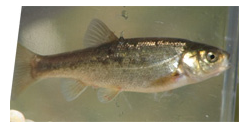Arroyo Chub are small chunky fish that rarely grow to more than five inches long. They are native to the streams and rivers of the Los Angeles plain, as well as the Santa Ana River and Lytle Creek in San Bernardino County, which like most of the streams of the region range from being muddy torrents during the winter to clear quiet brooks in the summer, possibly drying up in places.
The Arroyo Chub have also been introduced to the Mojave River system, in which they have eliminated the Mojave Tui Chub.
Known by its scientific name Gila orcutti, this fish has a deep body and caudal peduncle, large eyes, a short round snout and small sub-terminal mouth. Typically, these fish are silver or gray to olive green on top, with a white underside, and a dull gray lateral band. Males have larger fins than females and breeding males develop a patch of tubercles on the upper surface of its pectoral fins. They sport eight dorsal fin rays and seven anal fin rays. Typically, they feature anywhere between 48 to 62 lateral line scales and have five to nine gill rakers.
These fish have been extirpated from much of their native range, but have been introduced to streams along the coast as far north as Chorro Creek in San Luis Obispo County. Arroyo Chub are adapted to survive in cool to warm (47 degrees to 68 degrees Fahrenheit) streams that fluctuate between large winter storm flows, and low summer flows, and the low dissolved oxygen and wide temperature fluctuations associated with this flow regime. They are most common in slow flowing or backwater areas with sand or mud substrate, but may also inhabit fast moving sections with velocities in excess of 80 cm/s over coarse substrate, but generally deeper than sixteen inches.
They feed on plants such as algae and Azolla water fern, and on invertebrates such as insects and mollusks. Arroyo Chub reach a size of 3.2 to 3.6 inches by their fourth year and rarely live longer than this. Females can reproduce at age 1. Spawning takes place in pools and edge habitat from February to August with a peak in June and July. Several males may fertilize the eggs of one female. Fertilized eggs stick to plants or bottom substrate and hatch in about 4 days. Fry stay on the substrate for a few days, then rise to the surface and stay among plants or other cover for three to four months.
The species was given its name in honor of C. R. Orcutt, who in 1889 made the first collection of this fish by using a net.
SBCSentinel
News of note from around the largest county in the lower 48 states.

